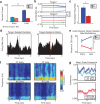Corticostriatal plasticity is necessary for learning intentional neuroprosthetic skills
- PMID: 22388818
- PMCID: PMC3477868
- DOI: 10.1038/nature10845
Corticostriatal plasticity is necessary for learning intentional neuroprosthetic skills
Abstract
The ability to learn new skills and perfect them with practice applies not only to physical skills but also to abstract skills, like motor planning or neuroprosthetic actions. Although plasticity in corticostriatal circuits has been implicated in learning physical skills, it remains unclear if similar circuits or processes are required for abstract skill learning. Here we use a novel behavioural task in rodents to investigate the role of corticostriatal plasticity in abstract skill learning. Rodents learned to control the pitch of an auditory cursor to reach one of two targets by modulating activity in primary motor cortex irrespective of physical movement. Degradation of the relation between action and outcome, as well as sensory-specific devaluation and omission tests, demonstrate that these learned neuroprosthetic actions are intentional and goal-directed, rather than habitual. Striatal neurons change their activity with learning, with more neurons modulating their activity in relation to target-reaching as learning progresses. Concomitantly, strong relations between the activity of neurons in motor cortex and the striatum emerge. Specific deletion of striatal NMDA receptors impairs the development of this corticostriatal plasticity, and disrupts the ability to learn neuroprosthetic skills. These results suggest that corticostriatal plasticity is necessary for abstract skill learning, and that neuroprosthetic movements capitalize on the neural circuitry involved in natural motor learning.
© 2012 Macmillan Publishers Limited. All rights reserved
Figures




Comment in
-
Neuroscience: how brains learn to control machines.Nature. 2012 Mar 4;483(7389):284-5. doi: 10.1038/nature10951. Nature. 2012. PMID: 22388810 No abstract available.
Similar articles
-
Selective corticostriatal plasticity during acquisition of an auditory discrimination task.Nature. 2015 May 21;521(7552):348-51. doi: 10.1038/nature14225. Epub 2015 Mar 2. Nature. 2015. PMID: 25731173 Free PMC article.
-
Coupling between motor cortex and striatum increases during sleep over long-term skill learning.Elife. 2021 Sep 10;10:e64303. doi: 10.7554/eLife.64303. Elife. 2021. PMID: 34505576 Free PMC article.
-
Neuroscience: how brains learn to control machines.Nature. 2012 Mar 4;483(7389):284-5. doi: 10.1038/nature10951. Nature. 2012. PMID: 22388810 No abstract available.
-
Circuit changes in motor cortex during motor skill learning.Neuroscience. 2018 Jan 1;368:283-297. doi: 10.1016/j.neuroscience.2017.09.010. Epub 2017 Sep 14. Neuroscience. 2018. PMID: 28918262 Free PMC article. Review.
-
Corticostriatal plasticity: life after the depression.Trends Neurosci. 2004 Aug;27(8):460-7. doi: 10.1016/j.tins.2004.06.010. Trends Neurosci. 2004. PMID: 15271493 Review.
Cited by
-
Single-trial cross-area neural population dynamics during long-term skill learning.Nat Commun. 2020 Aug 13;11(1):4057. doi: 10.1038/s41467-020-17902-1. Nat Commun. 2020. PMID: 32792523 Free PMC article.
-
One session of fMRI-Neurofeedback training on motor imagery modulates whole-brain effective connectivity and dynamical complexity.Cereb Cortex Commun. 2022 Jul 25;3(3):tgac027. doi: 10.1093/texcom/tgac027. eCollection 2022. Cereb Cortex Commun. 2022. PMID: 36072710 Free PMC article.
-
Intrinsic Variable Learning for Brain-Machine Interface Control by Human Anterior Intraparietal Cortex.Neuron. 2019 May 8;102(3):694-705.e3. doi: 10.1016/j.neuron.2019.02.012. Epub 2019 Mar 7. Neuron. 2019. PMID: 30853300 Free PMC article.
-
How learning unfolds in the brain: toward an optimization view.Neuron. 2021 Dec 1;109(23):3720-3735. doi: 10.1016/j.neuron.2021.09.005. Epub 2021 Oct 13. Neuron. 2021. PMID: 34648749 Free PMC article. Review.
-
A Common Function of Basal Ganglia-Cortical Circuits Subserving Speed in Both Motor and Cognitive Domains.eNeuro. 2017 Dec 8;4(6):ENEURO.0200-17.2017. doi: 10.1523/ENEURO.0200-17.2017. eCollection 2017 Nov-Dec. eNeuro. 2017. PMID: 29379873 Free PMC article.
References
-
- VanLehn K. Cognitive skill acquisition. Ann. Rev. Neurosci. 1996;47:513–539. - PubMed
-
- Barnes TD, Kubota Y, Hu D, Jin DZ, Graybiel AM. Activity of striatal neurons reflects dynamic encoding and recoding of procedural memories. Nature. 2005;437:1158–1161. - PubMed
-
- Brashers-Krug T, Shadmehr R, Bizzi E. Consolidation in human motor memory. Nature. 1996;382:252–255. - PubMed
Publication types
MeSH terms
Substances
Grants and funding
LinkOut - more resources
Full Text Sources
Other Literature Sources
Molecular Biology Databases

